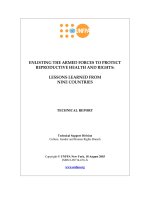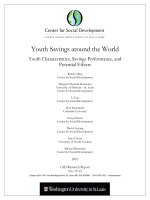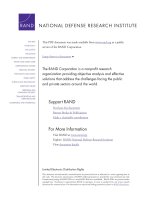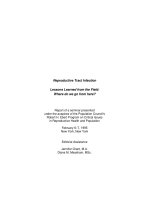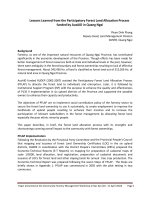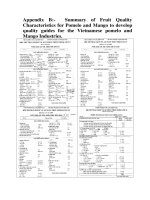The Accounting Fraud @ Worldcom: The Causes, The Characteristics, The Consequences, And The Lessons Learned
Bạn đang xem bản rút gọn của tài liệu. Xem và tải ngay bản đầy đủ của tài liệu tại đây (613.66 KB, 60 trang )
THE ACCOUNTING FRAUD @ WORLDCOM:
THE CAUSES, THE CHARACTERISTICS, THE CONSEQUENCES, AND THE
LESSONS LEARNED
by
JAVIRIYAH ASHRAF
A Thesis submitted in partial fulfillment of the requirements
for Honors in the Major Program in Accounting
in the College of Business Administration
and in The Burnett Honors College
at the University of Central Florida
Orlando, Florida
Spring Term
2011
Thesis Chair: Dr. Pamela Roush
Abstract
The economic prosperity of the late 1990s was characterized by a perceived expansive
growth that increased the expectations of a company‟s performance. WorldCom, a
telecommunications company, was a victim of these expectations that led to the evolution of a
fraud designed to deceive the public until the economic outlook improved. Through
understanding what led to the fraud, how the fraud grew, and what its effects were, lessons can
be derived to gain a better understanding of the reasons behind a fraud and to prevent future
frauds from occurring or growing as big as the WorldCom fraud did.
ii
Acknowledgements
Dr. Roush, for her patience, for her advice, for her time, and for her knowledge.
Dr. Benford and Dr. Gibbs, for their continued support and time as committee members.
Gene Morse, the internal auditor at WorldCom when all this happened, for his internal insight
into the case.
Thank you.
iii
Dedications
For my family, who fed me, clothed me, and distracted me, all to make sure I stay sane during
this knowledge gaining experience.
For the numerous cups of tea that made me fall asleep and saved me from information overload.
For my grandfathers: the businessmen.
iv
Contents
Introduction ..................................................................................................................................... 1
Causes ............................................................................................................................................. 3
Internal Environment .................................................................................................................. 3
Strategy (or lack thereof) ........................................................................................................ 3
Company Culture .................................................................................................................... 5
Corporate Governance .......................................................................................................... 10
Auditing: to detect or to neglect................................................................................................ 14
Audit Committee................................................................................................................... 14
Internal Audit ........................................................................................................................ 15
External Auditors .................................................................................................................. 16
External Environment ............................................................................................................... 18
Double Bubble ...................................................................................................................... 18
Greed at Wall Street .............................................................................................................. 20
Causes Conclusion .................................................................................................................... 23
Characteristics ............................................................................................................................... 25
Definition of Fraud ................................................................................................................... 25
The Misstatement of Line Costs ............................................................................................... 26
v
Releasing Accruals................................................................................................................ 26
Capitalizing Line Costs ......................................................................................................... 28
Revenue..................................................................................................................................... 29
Discovery .................................................................................................................................. 30
The Internal Auditors ............................................................................................................ 30
Sullivan‟s White Paper ......................................................................................................... 31
Fraud Triangle ........................................................................................................................... 32
Pressure ................................................................................................................................. 32
Opportunity ........................................................................................................................... 34
Rationalization ...................................................................................................................... 35
Characteristics Conclusion........................................................................................................ 36
Consequences ................................................................................................................................ 39
Effects on Internal Environment ............................................................................................... 39
Effects on External Environment .............................................................................................. 41
Regulations ............................................................................................................................... 43
Consequences Conclusion ........................................................................................................ 45
Conclusion .................................................................................................................................... 47
Appendix: Figures ......................................................................................................................... 48
Figure 1: Locations of WorldCom offices ................................................................................ 49
vi
Figure 2: Fraud Triangle ........................................................................................................... 50
Figure 3: Internal Control Structure .......................................................................................... 50
Works Cited .................................................................................................................................. 51
vii
Introduction
WorldCom was a provider of long distance phone services to businesses and residents. It
started as a small company known as Long Distance Discount Services (“LDDS”) that grew to
become the third largest telecommunications company in the United States due to the
management of Chief Executive Officer (“CEO”) Bernie Ebbers. It consisted of an employee
base of 85,000 workers at its peak with a presence in more than 65 countries. LDDS started in
1983. In 1985, Ebbers was recruited as an early investor of the company and became its CEO. It
went public four years later. Ebbers helped grow the small investment into a $30 billion revenue
producing company characterized by sixty acquisitions of other telecomm businesses in less than
a decade. In 1999, Ebbers was one of the richest Americans with a $1.4 billion net worth.
From the outside, WorldCom appeared to be a strong leader of growth. In reality, the
appearance was nothing more than a perception. On June 25, 2002, the company revealed that it
had been involved in fraudulent reporting of its numbers by stating a $3 billion profit when in
fact it was a half-a-billion dollar loss. After an investigation was conducted, a total of $11 billion
in misstatements was revealed.
To understand fraud, why it happened, and what it constitutes, it is important to
understand not only the details of the accounting methods, as is summarized in The Report of
Investigation conducted on WorldCom, but also what was happening in the environment of the
company while the fraud was occurring.
1
Therefore, the objective of this paper is to analyze the events that occurred before
(causes) and after (consequences) the fraud, the accounting tactics utilized to accomplish this
fraud (characteristics), and the lessons learned from each of the problems.
2
Causes
Internal Environment
Strategy (or lack thereof)
The executive and strategic decisions at WorldCom were characterized by rapid growth
through acquisitions (In re WorldCom, inc., 2003). “Growth, growth, growth…” (G. Morse
personal communication, October 22, 2010). By 1998, WorldCom had been involved in mergers
with sixty companies. Together, these transactions were valued at more than $70 billion, the
largest of which, MCI Communications Corporation (“MCI”), was completed on September 14,
1998, and was valued at $40 billion (In re WorldCom, 2003).
According to Smith & Walter (2006), WorldCom was motivated by the low interest rates
and rising stock prices during the 1990s. From the beginning it committed itself to the highgrowth strategies that relied on aggressive corporate actions that often involved “creative”
accounting practices.
Dick Thornburgh‟s investigation of WorldCom (2003) revealed a lack of strategic
planning, often depicted by nonexistent “proper corporate governance protocols.” While
documents called “strategic plans” were found, they only consisted of an overview of the
company‟s financial outlook in the event that WorldCom stopped the aggressive acquisitions.
They did not contain any realistic strategic plans (Thornburgh, 2003). There was no strategic
committee and the decision makers mainly consisted of Ebbers, Chief Financial Officer (“CFO”)
Scott Sullivan (“Sullivan”), and Chief Operations Officer (“COO”) John Sidgmore (“Sidgmore”)
(Thornburgh, 2003).
3
Once WorldCom acquired the new companies, it failed to properly integrate the systems
and policies that not only led to very high levels of overhead in proportion to the revenues but
also to an extremely weak internal control environment (Breeden, 2003). Due to the fast pace of
the acquisitions as well as management‟s neglect, the accounting systems at WorldCom were
unable to keep up with integration and efficiency. The lack of internal controls allowed manual
adjustments to be made in the system without the emergence of any red flags, thereby
minimizing any chance of detection (Breeden, 2003).
To further this acquisition problem, the MCI merger caused WorldCom to take on a huge
debt load. In addition, MCI had a residential customer base with slower growth rates while
WorldCom had historically served business customers, a customer base consisting of high
margins and less turnover. (Katz & Homer, 2008).
The beginning of WorldCom‟s fall came with its attempt to merge with the second largest
telecommunication company at the time: Sprint (WorldCom being the third largest). The plan
was terminated by the U.S. Department of Justice due to the lack of anti-competitiveness it
would create within the telecommunications industry. With no other companies to merge with,
WorldCom‟s growth through acquisitions strategy came to a screeching halt (Clikeman, 2009).
According to Porter (1985), a competitive strategy searches for a favorable competitive
position in a company‟s industry, aiming to establish a position in which the company is
profitable and sustainable against its competitors. The management at WorldCom was so
determined to grow that it not only failed to create a competitive strategy, but also did not see
4
that with growth comes “the need to maintain” to prosper. In the end, that lack of strategy
prevented it from effectively planning and determining a position to acquire that prosperity.
Company Culture
Top Management’s Managing Style
According to Albrecht & Albrecht (2004), to prevent fraud, the opportunity to commit
fraud should be minimal or nonexistent. Creating a work culture of “honesty, openness, and
assistance” is key to fraud prevention (Albrecht & Albrecht, 2004, p. 61). First, it is important to
hire honest people and train them in fraud awareness, and to present a code of conduct or ethics
that is not only stated on a piece of paper, but is truly respected and followed by other employees
including top management. Second, a positive work environment must be created. Third,
employees must be provided with assistance programs (Albrecht & Albrecht, 2004).
The growth through acquisitions “strategy” at WorldCom was enforced and reinforced by
top management. The consistent pressures from top management created an aggressive and
competitive culture (in re WorldCom, inc., 2003) that did not contain any communication of the
need for honesty or truthfulness or ethics within the company (Breeden, 2003). In fact, one
former executive reports that the pressure became “unbearable-greater than he had ever
experienced in his fourteen years with the Company” (Zekany, Braun, & Warder, 2004). One
employee stated that WorldCom was never a happy place to work, even when the company was
doing well, the employees were forced to work 10, 12, or even 15 hour days but it balanced out
with the higher compensation. However, when the stock dropped, the employees were still
5
required to work the long hours even when compensation was all but gone (L. Jeter, personal
communication, October 17, 2010).
There was a large focus on revenues, rather than on profit margins and the lack of
integration of accounting systems allowed WorldCom employees to move existing customer
accounts from one accounting system to another. This allowed the reporting of higher revenues
for WorldCom through which employees pocketed extra commissions that amounted to almost
$1 million (in Re WorldCom, inc., 2003). According to the Beresford, Katzenbach, & Rogers
(2003), efforts made to establish a corporate Code of Conduct received Ebbers‟s disapproval. He
often described the Code as a “colossal waste of time.” Implementing a code of ethics and
having employees read and sign it periodically can reinforce ethical conduct as well emphasize
that it is important to the company (Albrecht & Albrecht, 2004). The lack of a code of ethics at
WorldCom shows that no training on awareness of fraud or ethics was conducted. Therefore, it is
very possible that when the employees reported existing customers as new ones, they were not
aware of the obdurate consequences that may occur.
The employees at WorldCom did not have an outlet to express concerns about company
policy and behavior either. Special rewards were given to those employees who showed loyalty
to top management while those who did not feel comfortable in the work environment were
faced with obstacles in their need to express their concerns (Panday & Verma, 2004). Due to the
multiple acquisitions, WorldCom‟s business units were spread across the eastern United States
(see Figure 1). Hence, if an employee working at headquarters in Clinton, Mississippi was facing
a problem, he/she would have to contact the Human Resources department in either New York,
6
N.Y. or Boca Raton, Florida. This autonomous structure complicated matters further and
discouraged most employees from saying anything at all (Beresford, Katzenbach, & Rogers,
2003). The lack of an outlet to express concerns was not only problematic for regular employees,
but also for the upper level employees who were asked to participate in the fraud. Betty Vinson
and Troy Normand, managers in Clinton‟s Accounting Department, were told to make journal
entries on the instructions of the Director of General Accounting Buddy Yates (Beresford,
Katzenbach, & Rogers, 2003). They followed his orders. However, they both wrote a letter of
resignation after they felt uncomfortable with the falsified journal entries they made. The two
never submitted their resignation letter due to their dependence on their jobs to support their
families (Cooper, 2008).
A low fraud environment could have been created if WorldCom‟s culture consisted of
positive work environment elements such as employee assistance programs that make it easier
for the employees to not only report fraud, but decrease their own likelihood of committing it.
Open door policies, positive personnel, and operating procedures could have been implemented
to diminish the barrier between employees and upper management (Albrecht & Albrecht, 2004).
Unfortunately, in the case of WorldCom, the personnel themselves were involved in the fraud.
Yet, if the personnel were the ones to implement the positive work environment, they might not
have been involved in the fraud in the first place.
On top of the lack of an ethical code and an outlet for concerns was the concept of
employee compensation with stock options. Employees at WorldCom received a lower salary
than their counterparts at competitors such as AT&T and Sprint (J. Chalmers personal
7
communication, October 21, 2010). According to Chalmers, a lawyer who dealt with many
WorldCom employee cases after the fraud, the gap between the competitors‟ compensation and
WorldCom employee compensation was filled through stock options which further enforced
management‟s ideology of focus on revenues. The higher the revenues, the better the company
appeared to Wall Street which in turn led to a higher stock price and higher compensation for
both employees and management. However, when WorldCom fell, so did the stock price, leaving
its employees with worthless stock options. Gene Morse (personal communication, October 22,
2010), one of the internal auditors who helped discover the accounting fraud, had been given the
senior level director‟s stock options package. If the stock had returned to its high and WorldCom
had not fallen, his options would have been worth over $900,000. Morse stated that he never sold
the options because he too, like the majority of other employees and stakeholders, believed in
Ebbers‟s optimism about WorldCom.
Ebbers played a huge part in turning LDDS into a “global telecom giant,” WorldCom,
with the goal of acquiring the position as the “number one stock on Wall Street” (Panday &
Verma, 2004). Ebbers had started out by managing hotels in 1974 (Clikeman, 2009). He
continued his “hands on” managerial style throughout his involvement in WorldCom even when
the company had revenues amounting to billions of dollars (in re). He was known for taking risks
(Katz & Homer, 2008) no matter how aggressive, towards making WorldCom‟s stock a highly
demandable one. According to Panday & Verma (2004), Ebbers created an individualistic culture
where loyalty to a person was more important than loyalty to the company. This created an
environment where the boss was not to be questioned. Therefore Ebbers‟s plan was the
company‟s plan.
8
Sullivan was Ebbers‟s right hand man. He and Ebbers had the same managing style.
Sullivan was known as a “whiz kid” who enjoyed the reputation of “impeccable integrity.” He
was a leader that, like Ebbers, was not to be questioned. The loyalty that existed at WorldCom
was very important to keep the fraudulent activities that occurred bottled up. Most of the
information was not fully available to employees, furthering this secrecy. Even some who had
the need to know the information (Zekany, Braun, & Warder, 2004), such as the internal
auditors, were able to view only some of the journal entries in the income statement and the
balance sheet but never the entire documents (G. Morse Personal Communication, October 22,
2010).
The combined management allowed the creation of a culture that was more suitable for a
sole proprietorship than for a billion dollar corporation. The aggressive nature of the managing
style such as the plethora of acquisitions as well as the failure to integrate them properly created
an environment where employees were pressured to report high growths quarter by the quarter.
There was no emphasis or encouragement of honesty and integrity with those demands.
According to Romney & Steinbart (2008), a work environment that emphasizes “integrity and
commitment to both ethical values and competence” depicts good business, yet it all has to start
at the top. Management that required and rewarded integrity and honest behavior (Romney &
Steinbart, 2008) may have prevented what occurred at WorldCom. Furthermore, if management
had envisioned a more stable and long term outlook for the company, the quick paced
acquisitions may not have occurred. Unfortunately, they did. The approval for these acquisitions
was given by the Board of the Directors.
9
Corporate Governance
Board of Directors
According to Romney & Steinbart (2008), a Board of Directors that is active and
involved within an organization is an important internal control for the organization. The
directors at WorldCom were from different backgrounds. While some had widespread
knowledge and experience of business and legal issues, others were appointed due to their
connections with Ebbers (Breeden, 2003). The mix of the Board and the close ties to Ebbers led
to the Board‟s lack of awareness on WorldCom‟s issues. The Board was inactive and met only
about four times a year, not enough for a company growing at the rate that it was. In addition, the
directors were only given a small cash fee as compensation, thus an appreciation of stock was the
only form of compensation available. The directors also depended on company growth and stock
appreciation for compensation, as did the employees and management. They had a large amount
of influence on the approval or disapproval of company decisions. Their approvals of the
acquisitions allowed WorldCom‟s growth to an increase that led to a higher stock price and a
large amount of compensation. Directors dependent on this type of “large issuances of equity”
not only conveyed an unhealthy practice, but also created a conflict of interest where their goal
became more focused on the growth of the stock than on what was in the best interests of the
company (Breeden, 2003). Another conflict of interest arose for those board members that had
strong ties to Ebbers. Their closeness to Ebbers hurt their duty to be independent from the
company and its management.
10
Due to the Board‟s lack of active participation, there was a lack of awareness about
WorldCom‟s matters. According to Thornburgh (2003), management aided that lack of
awareness by presenting the directors with very limited information about the company and its
acquisitions. Thornburgh (2003) states multibillion dollar transactions were approved by Board
of Directors with the limited information. At times they were approved with discussions that
lasted less than half an hour. Sometimes these discussions did not involve the Board at all and at
other times no documents were even presented concerning the terms of the transactions. In
addition, no risk assessment was performed on these acquisitions (Breeden, 2003).
Romney & Steinbart (2008) recommend that the Board of Directors of a company should
be responsible for overseeing management and inspect its “plans, performance, and activities”
(p. 208).The directors should also approve the company‟s strategy, review its financial
statements, and evaluate security policy. They should also always interact with the auditors, both
external and internal.
Loans to Ebbers
“We stand by our accounting.” Ebbers made this statement during an earnings conference
call with analysts in February of 2002 (in Re WorldCom, inc., 2003). However, what was
unknown at the time was Ebbers‟s personal financial situation. Ebbers had made several
purchases for which he had acquired loans and used his WorldCom stock as collateral. The
purchases were quite extravagant and included the largest ranch in Canada, a yacht construction
firm and yard, a marina, motels, a hockey team, and even a yacht Ebbers named “Acquasition.”
Once the price of WorldCom stock fell, Ebbers was required by the banks to fill in the margins
11
between the value of his loans and the fallen value of his stocks (Panday & Verma, 2003).
Instead of selling his stock, which he thought would further cause a decline in stock price on
Wall Street, Ebbers requested the Board to approve personal loans to fill in the margins
(Breeden, 2003). To ease the process, Ebbers took advantage of the lack of independence of the
board members who were loyal to him such as Stiles Kellett, chairman of the Compensation
Committee, and Max Bobbitt, chairman of the audit committee. Not only did the two allow the
loans to grow to more than $400 million, but also when the Board found out about these loans,
they failed to take any action and allowed the loans to carry on (Breeden, 2003). A strong Board,
that included directors who were more focused on the shareholders rather than on what „Bernie‟
recommended, could have avoided the multimillion dollars in loans that further deteriorated
WorldCom‟s financial situation. This shows that it is important to inform the directors about
company policies, mission, and ethics since they are not a part of the company‟s daily life and
culture.
The Compensation Committee
One main reason Ebbers‟s loans were approved was the Compensation Committee. The
Committee‟s authority was stated in a charter from 1993 that listed a vague description of its
power to supervise the compensation of the officers (Beresford, Katzenbach, & Rogers, 2003).
However, in the company‟s proxy statements, the committee had the power to determine the
“salaries, bonuses, and benefits” of the officers (p. 270). The Committee approved the loans to
Ebbers without confirming with the Board and asked for the Board‟s approval after the loans had
already been paid out (Beresford, Katzenbach, & Rogers, 2003). The Committee was the only
one at WorldCom that met regularly: seven to seventeen times per year during the fraud period
12
of 1999-2001. Similar to the Board of Directors, the Compensation Committee failed to properly
conduct its role in placing appropriate pay programs that not only supported the company‟s
mission and strategy but were also in the best interests of the company. The approval of Ebbers‟s
loans does not qualify as an action in the company‟s best interests, but only in the best interests
of Ebbers and the board members who were loyal to him.
Lessons in Corporate Governance
Corporate governance involves the protection of shareholders by the Board of Directors
(P. Roush, personal communication, 2011). The approval of Ebbers‟s personal loans was not in
the best interests of the stakeholders. Breeden (2003) mentions that there are no “checklists” of
achieving “good” governance. There is, however, a need of a Board that contains individuals
who not only possess business knowledge and skills but also have “healthy sensitivity to norms
of proper behavior” (p. 23). The focus then turns to the creation of value for the company rather
than to simply avoid wrongdoing and to have a good code of ethics (Breeden, 2003).
Breeden further emphasizes “doing the right thing,” stating that every Board whether at a
national, business, or university level will at some point be faced with tough decisions and
challenges. The key to the success of the Board is to take action and resolve any problems with
competency (Breeden, 2003). Unfortunately, with WorldCom, when the Board was presented
with the challenge of approving Ebbers‟s loans, among other large acquisition decisions, it failed
to take action and limit Ebbers‟s power on the Board. Perhaps the Board did not realize the
consequences that could occur as a result of those actions committed against their long time
13
friend nor did it have the competency to take control of the board and take a strong position
against the decisions.
Auditing: to detect or to neglect
Audit Committee
A director‟s independence from management is a key factor in a successful company. At
WorldCom, an Audit Committee was established to conduct relations with Arthur Andersen, the
external auditor. An Audit Committee consists of a selected number of Board members who are
to meet from time to time with the company‟s auditing firm and discuss the progress of the audit,
the findings, and resolve any conflicts that may occur between management and the firm
(Louwers, Ramsay, Sinason, & Strawser, 2008). However, in WorldCom‟s case, the lack of
independence and awareness of the Board as a whole trickled down to the audit committee. The
committee‟s chairman, Max Bobbitt, was very loyal to Ebbers. Hence, the members of the
committee, including Bobbitt, were either unaware or had known about the fraudulent
misstatements for the years 1999, 2000, and 2001 and choose to ignore it. According to Breeden
(2003), the Committee oversaw the $30 billion revenue company when it met for about three to
six hours once a year.
While the Committee was represented positively, the accounting controls within were
“virtually non-existent” (in Re WorldCom, inc., 2003). It appears the lack of activity was more
of a “going through the motions” as opposed to the Committee sitting down and understanding
the policies, the internal controls, and the audit programs that were a necessity to the company‟s
core structure (Breeden, 2003). Even though Arthur Andersen acknowledged WorldCom as a
14
“maximum risk” client and mentioned to the Committee that WorldCom had “misapplied GAAP
(Generally Accepted Accounting Principles) with respect to certain investments,” the committee
chose to ignore it and in the end Arthur Andersen gave WorldCom a clean, unqualified opinion
(Zekany, Braun, & Warder, 2004).
The audit committee‟s negligence depicts another weakness in WorldCom‟s internal
controls. Therefore, it is very important to have members in the committee that fulfill their duties
by overseeing the corporation‟s internal control structure as well as making sure that the
company complies with “laws, regulations, and standards” (Romney & Steinbart, 2008). The
members should also periodically meet with the firm‟s internal and external auditors to ensure
the audit process is efficient and be aware of the company‟s operations. The fulfillment of these
duties is now a requirement due to Section 301 of the Sarbanes-Oxley Act discussed later.
Internal Audit
WorldCom‟s Audit Committee failed to meet with the Internal Auditors of the company,
who had the duty to provide the Audit Committee with an independent and objective view on
how to improve and add value to WorldCom‟s operations (Louwers, Ramsay, Sinason, &
Strawser, 2008). Not only were the personnel in the internal audit department not enough for a
large company, but they also lacked the proper training and experience to conduct the testing of
the company‟s controls.
According to Thornburgh (2003), Ebbers or Sullivan would have the department work on
“special projects” that were very time consuming and would normally not be part of the audit
function. Thornburgh states that there were times when the auditors would work on the projects
15
during the day and then stay late at night to complete the audits that were often delayed. Cynthia
Cooper, the Vice President of the Internal Audit function and the individual whose department
discovered and reported the fraud, stood by the intense work in the hopes that top management
would see her department as important and add the personnel and resources needed to efficiently
maintain the internal audit function (Thornburgh, 2003). Gene Morse (personal communication,
October 22, 2010) adds that the internal auditors were provided with limited access to the income
statements and balance sheets with only a partial picture of the company‟s financial situation that
prohibited them from properly assessing the finances of the company.
The Internal Audit department is intended to be independent and report directly to the
Audit Committee to avoid the influence of top management (Louwers, Ramsay, Sinason, &
Strawser, 2008). This form of relationship was lacking at WorldCom. Furthermore, Ebbers
wrongly associated the duties of an internal auditor with those of an external one. In reality, an
internal auditor does little work on the financial statements and focuses more on “improving the
organization‟s operations” (Louwers, 2008, p. 629), rather than conducting the actual operations.
The department must try to reduce or eliminate risks that could create losses and also improve
the efficiency of operations. Lastly, the department should help ensure compliance with
management, laws and regulations as this would add value to the company (Louwers, 2008).
External Auditors
At WorldCom, it appears there were no checks and balances in auditing. The internal
auditors were not sufficiently staffed to work on the internal controls and the audits of the
company which prevented them from correctly reporting to the Audit Committee about the
16
operational and financial situation of WorldCom. The Committee itself did not meet on a regular
basis either and was unable to properly take actions to fix the situation. Yet, the external auditor,
Arthur Andersen, was the one responsible for providing an independent opinion of the financial
situation at WorldCom for investors and creditors. The auditing firm also failed to carry out its
duties properly.
According to Beresford, Katzenbach, & Rogers (2003), Arthur Andersen‟s failure to
detect the fraud was due in part to negligence and in part to the tight control top management
kept over information. A flaw in Andersen‟s approach was that it limited its testing of account
balances, relying on WorldCom‟s perceived strong internal control environment (Beresford,
Katzenbach, & Rogers, 2003). Unfortunately, WorldCom‟s internal control environment was
inefficient in many ways, and therefore allowed Andersen to overlook “serious deficiencies” that
existed in the internal environment (p. 223). If the external auditors had performed their work
properly, the fraud could have been discovered long before 2002. Moreover, even though the top
management‟s control over the information was suspicious, Andersen failed to bring this
problem to the attention of the Audit Committee (Beresford, Katzenbach, & Rogers, 2003).
Speaking at an event at Baylor University, David Myers, former comptroller at
WorldCom, stated that the WorldCom audit was Arthur Andersen‟s largest audit in the region,
and that Arthur Andersen wanted to keep WorldCom as a client (Acc guest 2009). Unfortunately,
the retaining of WorldCom as a client was due to the consulting revenue that it brought in to
Arthur Andersen. The auditors spent more time selling those consulting services and less time
conducting analytical reviews and testing controls. According to Roush (personal
17
communication, 2011), this situation created a conflict of interest because the auditors would
first consult a company about how to increase performance or efficiency and then go back to the
same company and independently audit it. Top management at WorldCom was aware of this and
made the journal entries in the way they would be tested by Arthur Andersen. In addition, Myers
notes that Arthur Andersen may not have overlooked the details purposely but rather the auditors
were pressured to have the job completed as soon as they could. It appears that the relationship
with WorldCom was more valued than performing appropriate audit work. Andersen‟s close
relationship with Ebbers, in the end, resulted in a lack of professional skepticism: the questioning
attitude an auditor must have when in the field.
External Environment
The external environment during the fraud period also served as a basis for WorldCom‟s
growth during the Internet bubble. When the bubble burst in early 2000, WorldCom‟s share price
plummeted along with most of the volatile Internet and telecommunications companies.
Double Bubble
Dot-Com Bubble
In 1996, UUNet, the technology and Internet sector of WorldCom, announced that
Internet traffic was doubling every 100 days. According to Odlyzko (2003), while the statement
may have been true from 1996-1997, when Internet was indeed growing, the growth failed to be
carried on towards the later years when it was most often cited. This statement was not only
made by Internet and telecommunications companies to boost investment in their companies, but
also, by scientists trying to demonstrate the need for research within this new technology
18
